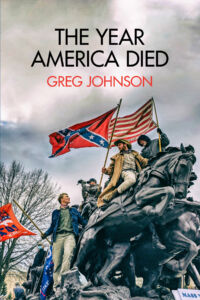Will Charlottesville Finally Unite the Right?
Posted By Thomas Steuben On In North American New Right | Comments DisabledA blogger associated with the antifa bragged at the beginning of this week that arrests were imminent against demonstrators who had participated in the August 11, 2017 tiki torch march in Charlottesville, Virginia. Three people have been arrested so far, but this may be only the beginning.
The law which is being abused is Virginia Code Section 18.2-423.01 [2], which in Subsection B states:
Any person who, with the intent of intimidating any person or group of persons, burns an object on a highway or other public place in a manner having a direct tendency to place another person in reasonable fear or apprehension of death or bodily injury is guilty of a Class 6 felony. (emphasis added)
Subsection A deals with burning objects on private property, and thus is not applicable.
The emphasis above is important. To prove a crime beyond a reasonable doubt, the prosecution must prove each and every element of that crime beyond a reasonable doubt. It is rare for actions in themselves to constitute a crime. There is usually a requirement of a mens rea, or a subjective guilty state of mind that accompanies the act. This state of mind ranges on a spectrum from mere criminal negligence through recklessness all the way to specific intent, depending on the statute.
The following is how the above statute could be simplified and rewritten to show each element:
- a defendant burns an object in public;
- a defendant subjectively intends to intimidate others; or
- the burning objectively has a direct tendency to place another person in a reasonable fear or apprehension of death or bodily injury.
It is noteworthy that this statute has an objective element. When laws say “reasonable,” they tend to mean a reasonable, ordinary person — although in 2023, what is reasonable can wildly vary based on political persuasion and so on.
The subjective, and more importantly objective, elements are designed to prevent the statute from running off into the realm of absurdity and unconstitutionality. Otherwise, it would be a felony to smoke a cigarette on the sidewalk if it causes an overly sensitive snowflake to fuss about cancer.
In an objective American court of law, no prosecutor could hope to successfully charge any of the Charlottesville marchers with this statute. The facts simply don’t fit. What type of idiot thinks that a tiki torch could be an effective tool of intimidation? It’s not even a medieval-style torch, has a small flame, and is really more of a Hawaiian-themed flashlight. And who before post-Charlottesville hysterics associated tiki torches with nationalism, let alone intimidation?
Statutes should not be read in a vacuum. Section 18.2-423.01 is under Article 5 [3], “Activities Tending to Cause Violence,” the first statute of which is Section 18.2-420, “Clandestine Organization defined,” which uses many words to describe the Ku Klux Klan or a similar organization without explicitly naming the Klan. Section 18.2-423 deals with burning crosses in public (more on that later), 18.2-423.1 with placing swastikas on property, and 18.2-423.2 with displaying nooses in public with intent to intimidate.
We don’t need tarot cards to divine the legislative intent of this statute. It was obviously passed during the civil rights era, which gave new and novel rights everyone except whites while undermining historical rights enjoyed by whites such as freedom of association. As explained in The America Regime, the civil rights era was tantamount to a new foundation myth, state religion, and Constitution.[1] [4] Even most conservatives have embraced this new paradigm, despite how white Americans initially vehemently opposed it.
Applying this statute to the tiki torch marchers is ludicrous even under the civil rights-era paradigm, however. Ambiguous terms can be clarified by other words they are associated with. Section 18.2-423.01 appears to have been a catch-all for instances when people might burn objects other than crosses to evade the statute, such as perhaps effigies. A tiki torch is not in the same category of intimidation as a noose, swastika, or burning cross, especially when tiki torches were yet to be slandered in the media.
The civil rights-era paradigm at least had a veneer of justice and objectivity in order to lure gullible whites into thinking that wildly disparate — and oftentimes hostile — races could co-exist under a system of neutral rules. But we are currently living through another foundation myth: the all-out culture war which began in 2016, culminating in the race riots and Democrat coup of 2020, and that is still ongoing. Under this paradigm, we have undeniably passed from what Carl Schmitt would deem “neutrality” and mere “policymaking” into the realm of true politics directed against objective enemies — not that the previous pretention to neutrality was anything but a façade.
 [5]
[5]You can buy Greg Johnson’s The Year America Died here. [6]
Truth was the first casualty in this conflict. The mask has finally slipped. We are no longer dealing with the slow erosion of traditional rights and jurisprudence, but open lawfare. The response to Charlottesville is ultimately about power and politics. “The law,” as that term is commonly understood, is entirely irrelevant beyond being the context in which this conflict is being fought.
That white citizens could be hauled hundreds of miles to another state’s court to face a hostile judge, prosecutor, jury, and highly questionable public defenders for an incident that happened over six years ago — Virginia has no statute of limitations for felonies — is reminiscent of American patriots being hauled before hostile British courts. This unjust farce prompted the Founders to explicitly enumerate the Anglo-Saxon right to a fair and speedy trial in the Seventh Amendment. That courts in liberal areas now resemble hostile kangaroo courts in totalitarian states is a strong argument for why we need a national divorce.
But let us turn to predictions and practical advice. As of the morning of April 19 [7], there have only been reports of three arrests. The defendants’ names and details are not publicly known at this time, but it is likely that Jim Hingeley, Albemarle County’s Soros-backed [8] Commonwealth Attorney, will continue to target the marchers unless there is stiff resistance. As demonstrated by January 6, the Left is viciously vengeful and is unlikely to cease their reign of anarcho-tyranny if the broader Right continues to behave as pushovers. There is every incentive for them to use the law in the pursuit of vengeance, with few downsides.
We must therefore be prepared to circle the wagons and unconditionally back anyone and everyone who is targeted. Yes, this may include less-than-perfect people who may have made what in retrospect were poor decisions on that day. Too often those on the Right, especially on the Alt Right, have been quick to disparage those targeted by anarcho-tyranny as deserving of their fate.
I confess I have caught myself doing this a few times. It is a coping mechanism, because it is psychologically hard to accept that we, too, could be targeted. And it plays right into the Saul Alinsky tactic of isolating a target so that he can be destroyed. Unless there is unified pushback, it is likely that Jim Hingeley will expand his prosecution to anyone who was there who his comrades in antifa have doxed, regardless of their individual conduct.
There is reason for hope, however. As noted by RedState [7], the Virginia statute which specifically deals with burning crosses did not fare well before the Supreme Court in Virginia v. Black, 538 U.S. 343 (2003). [9] The statute states that cross-burning in itself implicitly indicates an intent to intimidate regardless of the context, and thus the prosecution does not need to prove intent. In Virginia v. Black, a plurality of the SCOTUS ruled that cross-burning with proven intent to intimidate could be banned, but that cross-burning in itself does not constitute prima facie intent to intimidate. It is therefore unlikely that applying this statute to the burning of generic objects would pass a Supreme Court review unscathed, if at all. Additionally, an appellate court, even if it is liberal, could rule in favor of the defendants in order to head off a landmark SCOTUS decision that would in turn create binding case law for the whole country.
It will be difficult in the short term for anyone targeted, as undergoing the legal process itself is often as bad as or even worse than the substantive outcome. But this particular act of persecution may prove to be an overextension that pays massive dividends in the long run.
Prosecuting the Charlottesville marchers is an outrageous injustice. The first instinct of anyone closer to the mainstream is to throw these victims to the wolves. But that is foolish. There are wolves in every jurisdiction, and they aren’t just coming for the Alt Right. You might have thought it prudent to toss the January 6 victims to the wolves as well. But now that they have indicted Donald Trump himself, it should finally sink in: these wolves are coming for all of us. So it is unite or die.
If, however, we can defeat them in Charlottesville, it might slow or stop such lawfare before it gets out of hand. But to do that, we need to protest with one voice. Let’s make them regret this. Let’s make Charlottesville the place we finally Unite the Right.
* * *
Counter-Currents has extended special privileges to those who donate $120 or more per year.
- First, donor comments will appear immediately instead of waiting in a moderation queue. (People who abuse this privilege will lose it.)
- Second, donors will have immediate access to all Counter-Currents posts. Non-donors will find that one post a day, five posts a week will be behind a “Paywall” and will be available to the general public after 30 days.
- Third, Paywall members have the ability to edit their comments.
- Fourth, Paywall members can “commission” a yearly article from Counter-Currents. Just send a question that you’d like to have discussed to [email protected] [10]. (Obviously, the topics must be suitable to Counter-Currents and its broader project, as well as the interests and expertise of our writers.)
To get full access to all content behind the paywall, sign up here:
Paywall Gift Subscriptions
 [11]If you are already behind the paywall and want to share the benefits, Counter-Currents also offers paywall gift subscriptions. We need just five things from you:
[11]If you are already behind the paywall and want to share the benefits, Counter-Currents also offers paywall gift subscriptions. We need just five things from you:
- your payment
- the recipient’s name
- the recipient’s email address
- your name
- your email address
To register, just fill out this form and we will walk you through the payment and registration process. There are a number of different payment options.
Note
[1] [12] An Anonymous January 6 Prisoner, The American Regime (Quakertown, Pa.: Antelope Hill Publishing, 2023), pp. 20-26.
